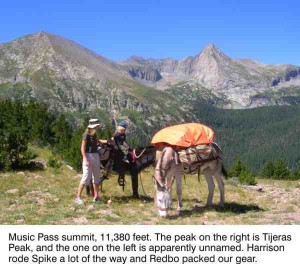Essay by Bryce Andrews
Agriculture – October 2007 – Colorado Central Magazine
THROUGH THE END of June last year, we got along fine with the wolves. I was working on a ranch in Montana’s Madison Valley, where the wolves ran elk to exhaustion in the high country while yearling cattle fattened on the lower pastures of the ranch. Peaceful coexistence with predators seemed within our grasp, and that was our goal, just to get along.
Near the middle of July, we gathered 780 heifers from the grassy flats by the river and drove them onto the Squaw Creek Allotment, a crumpled tablecloth of tree-covered draws, bare ridges and seeps at the base of the Madison Range. We settled our herd and left them munching Forest Service grass.
Within 24 hours, we were in trouble. On the first morning, a heifer stood apart. As I walked her up the fence, I saw the bloody stripes just under her tail, gaped at the rip in her bag that opened to darkness with every step. From then on, life accelerated to a blur. What I recall clearly is that the animal corpses appeared with maddening frequency. One lay bloated in a stream. Two others were gnawed to bare bone. I couldn’t help it; my rage grew with the body count. I thought of Aldo Leopold’s famous line about a fierce green fire in a wolf’s eye, and I wanted to see it die.
After performing an autopsy on one of the cows, Montana’s Department of Fish, Wildlife and Parks issued a shoot-on-sight permit for two wolves. A few days later, with a borrowed 30-30, I filled half of it.
I killed the first one at South Squaw Creek, which begins as a quagmire of thick undergrowth, fallen trees and shadow. Through this, deft and massive, came the wolf. We saw each other simultaneously, and then I fired and watched his hind end go limp and collapse. He dragged doggedly toward shelter. I shot again and hit a tree. I shot a third time, and he tumbled out of view. I found him breathing out his last in a clearing not ten feet across. He seemed to fill it. A moment, and he was gone, leaving me heartsick with the shot ringing in my ears.
I’d killed the alpha male. The following day another ranch hand shot a half-grown pup. Afterward, it took a while to restart my mind. When I closed my eyes the scene appeared, the trigger-pull, impact. I heard again the hiss of air from punctured lungs and wondered if something that felt so wrong could be positive in any sense.
Removed from the moment, I take solace in our success. Within days of the shooting, the rest of the pack retreated to the mountains. We killed two wolves, but by ending the string of depredations, spared eleven. Other ranchers in the valley took notice. For these reasons, I consider the killing of the wolf to be the most effective conservation act of my life.
I wish the story ended there, with a moderate example set and the wolves dining permanently on elk. It was so until Sept. 18, when an early winter storm pummeled the valley. After the snow stopped flying and the fog lifted, I found two limping heifers with their backsides chewed away. We put the cattle down, and, caught shorthanded in a busy season, turned the wolf situation over to the governmental powers. They trapped and radio-collared a young male feeding on one of the carcasses. As we gathered and shipped our heifers, an aerial gunner killed the collared pup and two others.
Achieving equilibrium with wildlife on the margins of a domesticated world is an imprecise and sometimes violent undertaking. Wolves and cattle die. Ranchers lose sleep, money and their tempers. But so long as places like the Madison Valley remain open and undeveloped, there’s hope in the turning seasons. We can try to do the whole thing over, wiser for the lessons of a troubled summer.
This April, I crouched with a friend near a wolf den. It was dug into a steep hillside, its entrance framed by the roots of a pine. We thought the den was empty, but when our conversation lapsed, the pups mewled faintly from the dark. I thought of the heifers that would graze here in a month, and I recalled the mutilations and the rage I felt last summer. Here was a new generation of culprits. In a year they would be grown and hungry. They would maim and then vanish. We might have killed them if not for that muffled sound. But when we stood to go it rose above the wind, fragile, and something like a howl.
Bryce Andrews is a contributor to Writers on the Range, a service of High Country News. He lives in Seattle, Washington, and begins graduate school in environmental studies next month at the University of Montana, Missoula

